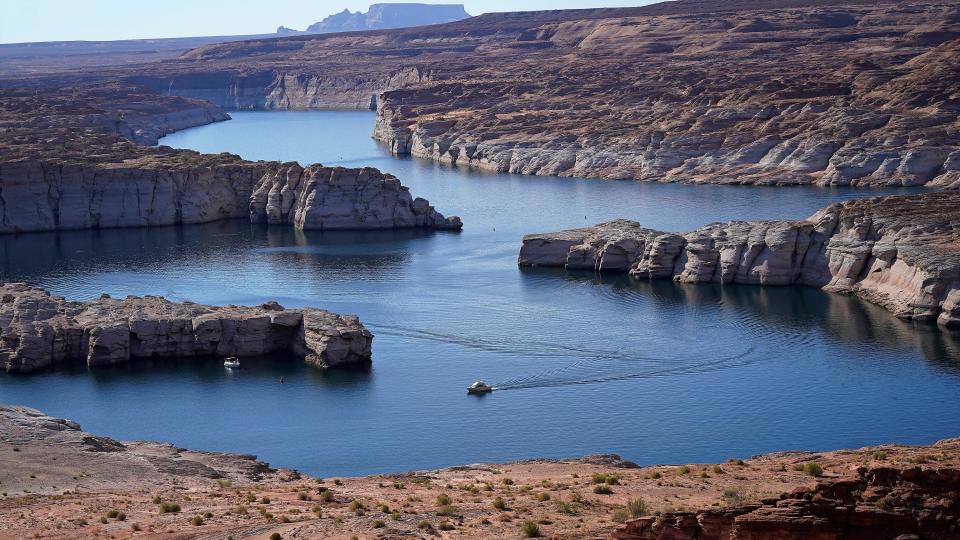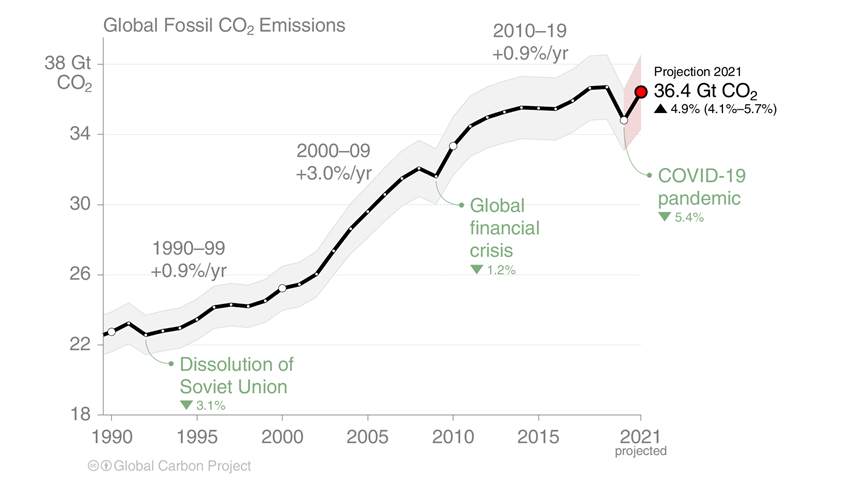Humanity healed the ozone hole. Can we do the same for climate change?
- Oops!Something went wrong.Please try again later.
The year was 1987, and Earth's shield against the giant thermonuclear reaction in the sky was failing.
Human-made chemicals in aerosol cans and refrigeration were eating up a thin protective layer of atmospheric gas called ozone, and heavy doses of radiation from the sun were leaking through. Scientists warned of a dangerous weak spot over Antarctica – the “ozone hole” – and a dire future.
Unless the world's 5 billion people took collective action, they said, the hole would grow and new ones would form at higher latitudes and roam the planet. Rates of skin cancer and blindness would increase, and plant and animal life would suffer unpredictable harm.
But that fate was averted. In September 1987, the United States and dozens of key nations signed the Montreal Protocol, a binding agreement to phase out the ozone-depleting substances, particularly chlorofluorocarbons (CFCs) and halons. Three decades later, emissions of the substances have dropped more than 99%, their presence in the atmosphere has halved, and the ozone hole is on track to fully heal by 2070.
"We've reached a critical milestone," said Stephanie Haysmith, a communications officer with the United Nations' Ozone Secretariat. "We're on the right path."

But while the ozone risk has diminished, another global threat has ramped up: human-caused climate change. Experts say that challenge is more complex and more pressing than ozone depletion and drives a need to learn from the Montreal Protocol and repeat its success.
And unlike ozone, humanity is "heading in the wrong direction" on climate, a United Nations report warned this month. In 2021, carbon dioxide, the most problematic greenhouse gas, reached its highest concentration in the atmosphere in at least 3 million years.
Humanity now has less than 30 years left until 2050, when the U.N. warns the world must reach "net zero," a point of equilibrium where any greenhouse gases emitted into the atmosphere are offset by methods to remove them.
Otherwise, the risks of devastating natural disasters will escalate beyond the already rapid-fire rate they're striking now, transforming the planet into one less hospitable to human life.

Susan Solomon, an atmospheric chemist at the Massachusetts Institute of Technology, who has studied both ozone loss and climate change, has seen the world tackle one major threat. Now she wonders, what did we learn about how to do it again?
"We avoided a global catastrophe. It's really quite an achievement." Solomon said. "How did we do that?"

Lessons learned
Haysmith, whose office at the U.N. administers and enforces the Montreal Protocol worldwide, says there was an early key to its success: Policymakers listened to scientists. Then they acted.
“There was sound, science-based decision-making, followed by solid policy implementation,” Haysmith said.
In the U.S., Congress ratified the Montreal Protocol and in 1990 passed ozone amendments to the Clean Air Act. The Environmental Protection Agency rolled out a number of regulations and phased out CFCs.
Internationally, key countries such as Germany and the United Kingdom took similar measures, said Michael Oppenheimer, a professor of geosciences and international affairs at Princeton University. And crucially, such wealthy nations provided funding for developing nations to phase out their use of ozone-depleting chemicals.
"Countries like India and China didn't see any benefit of getting into the business" of making harmful chemicals, Oppenheimer said. "Especially with this fund setup."
Finally, the protocol balanced “carrots” with “sticks” – measures to nudge countries toward compliance.
If a country doesn't meet its reduction commitments under the protocol, it's first given a chance to return to compliance and may be offered additional financial or technical assistance. But if it continues to emit the substances, it risks losing the financial aid and could face bans on imports underpinning its emissions.
Nations can even be suspended from the treaty. But that penalty has never been exercised, according to Liazzat Rabbiosi, a compliance officer with the U.N.'s Ozone Secretariat.

Experts says these measures contrast sharply with developments on climate change.
In 1997, the international community gathered in Japan to sign the Kyoto Protocol, a similar treaty seeking to decrease greenhouse gas emissions. But there were key differences, experts say. Enforcement mechanisms were weaker. Some nations, most notably the United States, never joined. Then-President Bill Clinton signed the agreement, but the Senate signaled disapproval and the protocol was never submitted for ratification.
Results have been shaky even for countries that did sign. Global greenhouse gas emissions have continued to increase. The international community tried a fresh approach by ratifying the Paris Agreement in 2015, but that too has run into trouble.
In the U.S., efforts by the EPA to regulate greenhouse gas emissions have been successfully challenged in court, and Congress failed to pass meaningful legislation until the climate-heavy Inflation Reduction Act this year.
More: 'Big problems': The Supreme Court handcuffed EPA on climate change. What comes next?
Meanwhile, China has grown into the world's largest emitter of greenhouse gases in large part because of heavy use of coal. And Europe, a world leader to date, risks backsliding amid an energy crunch spurred by Russia's invasion of Ukraine and COVID-19-related market shocks, experts say.
Key momentum growing?
Yet hope remains.
To solve any environmental challenge, Solomon said, it must meet the "Three P's": Is it easily perceptible, are the stakes personal, and are the solutions practical?
When the world confronted the ozone hole, the answer to each question was yes, Solomon said. Most people understand sunburn, and many fear developing skin cancer or cataracts from overexposure. Plus, a large part of the solution was as simple as switching deodorants.
“It was an amazingly practical thing that people did, which the American public should be proud of,” Solomon said. “We stopped buying new cans of hairspray and underarm deodorant and switched to roll-on. What could be easier than that?”

Public concern over the ozone hole also was instrumental in motivating regulators and industry to change, Solomon said. Affordable replacement chemicals for ozone-depleting substances were developed, further accelerating solutions.
Climate change has been more challenging. It can be difficult for humans to perceive how climate change amplifies naturally occurring weather phenomena, which also means it's hard to understand how it personally affects them.
“We're very good at fighting hot crises,” Solomon said. “But we're bad at problems that are slow but very serious.”

The solutions for climate change don't come so easily. Where most ozone-eating substances were used in just a handful of sectors, virtually the entire world economy is built around fossil fuels.
But Solomon feels the tides are changing.
As more Americans are affected by extreme weather and global disasters strike wealthy and developing nations alike, polling shows concern over climate change is increasing. Activism is rising alongside, particularly among younger generations who will inherit the post-2050 Earth and are starting to come into economic and professional power.
More: The kids are all fight: How millennials, Gen Z are driving change on climate
And perhaps even more important, solutions are becoming attainable. Rapid drops in the costs of solar energy have made it the most cost-effective power source available in the United States. Adoption of technologies such as electric cars appear to be reaching inflection points.
Consumer choice matters, Oppenheimer said. Just as Americans switched deodorants to heal the atmosphere, they can combat climate change by choosing sustainable products with lower carbon emissions.
But that consumer choice has its limits, especially when solutions cost more. That's where Oppenheimer believes government intervention is essential to research new solutions, bring down their costs and require industries to adopt them.
More: 'Shouting distance': That's how close the Inflation Reduction Act would get US to its climate goals
“Industry, when it has an incentive like the threat of regulation, is quite capable of producing what we need,” he said.
Building on successes
Humanity's fight against the ozone hole is already paying direct dividends on climate change.
Healing the ozone and preventing an increase in UV radiation has averted substantial global warming to date, scientists say, a benefit that could extend to 2.5 degrees by end of century. That has given humanity a chance to limit overall warming below 1.5 degrees, a crucial threshold in keeping the planet hospitable.

Even a global network of climate monitoring equipment established to measure ozone is now proving useful, according to Gerald Nedoluha, a research physicist with the Naval Research Laboratory.
"All of these instruments set up to monitor ozone destruction are now being used detect climate change," Nedoluha said.
The data produced by the machines shows potential. It took years after the Montreal Protocol was signed for atmospheric concentrations of CFCs to peak, but then they rapidly dropped.

In a similar fashion, data shows humanity flattening its annual emissions of carbon dioxide in recent years after a century of mostly meteoric rise. While the total amount in the atmosphere remains as high as ever, the possibility of a similar downturn remains in the cards, as long as humans resolve to do it.
"You can't say that people can't change the system," Solomon said. "But it has to be powered by public demand."
This article originally appeared on USA TODAY: Can the success stopping the ozone hole be applied to climate change?
